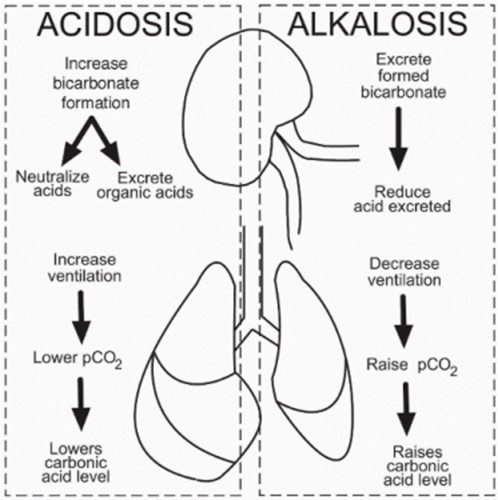Colleen, a 19 year old Freshman, was drinking alcohol at a frat party. She stupors, falls and hits her head on the ground. Her friend Julie dials "911" because Colleen is now unconscious, depressed ventilation (shallow and slow respirations), rapid heart rate, and is profusely bleeding from both ears. Which primary acid-base imbalance is Colleen at risk for if medical attention is not provided?
Metabolic Acidosis
Respiratory Acidosis
Respiratory Alkalosis
Metabolic Alkalosis
The Correct Answer is B
Respiratory acidosis is a primary acid-base imbalance that occurs when there is an excess of carbon dioxide (CO2) in the body due to impaired ventilation or inadequate removal of CO2 from the lungs. In this case, Colleen's depressed ventilation, indicated by shallow and slow respirations, can lead to inadequate elimination of CO2 from her body. The excessive CO2 levels can result in an accumulation of carbonic acid (H2CO3) in the blood, leading to an increase in acidity and a decrease in pH.
The profuse bleeding from both ears indicates a potential head injury, which can lead to decreased neurological function and impaired control over the respiratory center in the brain. This can further contribute to depressed ventilation and the development of respiratory acidosis. Metabolic acidosis, characterized by a decrease in bicarbonate (HCO3-) levels or an increase in non-carbonic acids in the blood, is not the primary acid-base imbalance in this case since the scenario does not provide information indicating a primary metabolic disorder. Respiratory alkalosis, characterized by decreased levels of CO2 in the blood, leading to increased pH and alkalinity, is not the primary acid-base imbalance in this case. The depressed ventilation and associated increase in CO2 levels indicate the opposite, respiratory acidosis. Metabolic alkalosis, characterized by an increase in bicarbonate levels or a decrease in non-carbonic acids, is not the primary acid-base imbalance in this case as the scenario does not provide information indicating a primary metabolic disorder.

Nursing Test Bank
Naxlex Comprehensive Predictor Exams
Related Questions
Correct Answer is D
Explanation
Chemotherapy is a treatment modality used to target and destroy rapidly dividing cells, including cancer cells. It works by interfering with the cell division process, which is a characteristic of cancer cells. However, it is important to note that chemotherapy drugs can also affect normal, healthy cells in the body that undergo rapid division, such as cells in the bone marrow, hair follicles, and gastrointestinal lining. This is why chemotherapy can be associated with side effects like bone marrow suppression, hair loss, and gastrointestinal disturbances. While the molecular structure of DNA can be altered by certain chemotherapeutic drugs, this explanation is not comprehensive enough to encompass the overall mechanism of action of chemotherapy.
The statement that "cancer cells are susceptible to drug toxins" is partially true, as cancer cells are generally more vulnerable to the cytotoxic effects of chemotherapy drugs compared to normal cells.
Chemotherapy aims to disrupt the division and growth of cancer cells rather than promoting their division.

Correct Answer is C
Explanation
A low-pressure ventilator alarm indicates a potential issue with the delivery of adequate air or pressure from the ventilator. The pulse oximetry reading of 85% suggests that the client is not receiving sufficient oxygenation.
Providing ventilation with a bag-valve-mask device allows the nurse to manually assist the client's breathing and ensure proper oxygenation and ventilation while troubleshooting the ventilator alarm. By manually ventilating the client, the nurse can help maintain oxygenation and prevent further hypoxemia until the underlying cause of the alarm can be identified and resolved.
Suctioning the client's endotracheal tube, adding air to the pilot balloon, or placing a bit block in the client's mouth may be appropriate interventions in specific situations, but they are not the immediate priority in this case. The primary concern is to address the low oxygen saturation and ensure adequate ventilation.
Whether you are a student looking to ace your exams or a practicing nurse seeking to enhance your expertise , our nursing education contents will empower you with the confidence and competence to make a difference in the lives of patients and become a respected leader in the healthcare field.
Visit Naxlex, invest in your future and unlock endless possibilities with our unparalleled nursing education contents today
Report Wrong Answer on the Current Question
Do you disagree with the answer? If yes, what is your expected answer? Explain.
Kindly be descriptive with the issue you are facing.
